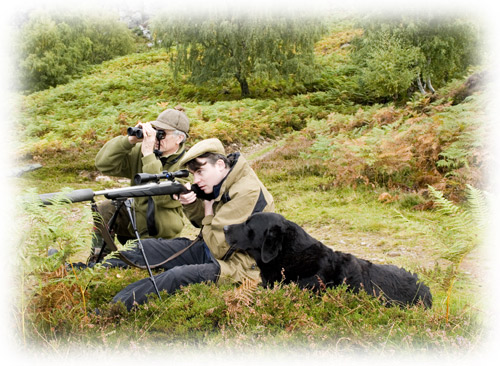Aim

The aim is to provide guidance 1 for land owners/managers, agents and guides involved in providing clients with a deer management experience which:
- Ensures the health & safety of the client and guide;
- Maintains deer welfare standards;
- Offers good value;
- Accommodates the practical needs of client;
- Provides high but achievable standards of service;
- Provides an enjoyable and informative day out.
Pre-event preparation
Prior to accepting clients, ensure the following are in place:
- Ensure that a risk assessment relevant to the activity has been carried out.
- Ensure that all necessary equipment is clean and safe to use and meets the manufacturer’s requirements.
- Ensure all staff have received appropriate training (i.e. machinery, first aid, trained hunter).
- An insurance policy with appropriate /adequate cover.
- Ensure, as far as possible, that additional services (e.g. off-site accommodation) meet the standards you require (e.g. provision of practical aspects such as firearms security and drying room) and what clients expect.
First impressions will go a long way in presenting a professional level of service. An experience in which standards of maintenance, cleanliness, presentation are high, will help achieve this.
The enquiry & booking process
In most instances enquiries and bookings from clients will be administered elsewhere.
- Where you are responsible for dealing directly with client enquiries, ensure that these are dealt with promptly, efficiently and professionally.
Pre-event information
Information for Guide
- Ensure that you are satisfied that the client meets legal requirements in relation to the use of firearms. For information on Visitor Permits Permits see BPG Firearms: Security, Transport & Storage.
Ensure that you obtain the following information:
- • Health issues/ fitness;
- • Number, age & gender of client/s;
• Experience;
•Travel and accommodation arrangements and requirements-including suitability of meeting point, lunch requirements;
• Equipment needs;
• Itinerary for stay;
• Client expectations.
• Confirmation/evidence that the client is adequately insured;
• Client conversant in English.
Information for client & agent:
Ensure that the client has the following information at the time of booking:
- Awareness of potential risks/ hazards;*
- Appropriate clothing, footwear and equipment;
- Description of event e.g. species, terrain, weather, duration, timings;
- Firearms (licences / permits, legal requirements of calibre and ammunition relevant to activity, storage facilities available).*
- A clear and precise schedule of base costs and any extra costs, net and gross of VAT.
Providing the client with the following additional information may add value to the experience:
- transport links;
- local accommodation;
- local amenities;
- points of interest (i.e. visitor attractions etc.);
- alternative activities.
On Arrival
- Ensure that the meeting point is easily located and identifiable (a postcode may be useful).
- Provide a welcoming arrival-put client at ease.
- Ensure that you are aware of any relevant health issues of the client that may need to be taken into consideration.
- Ensure that you satisfy yourself that the client and their equipment are capable of carrying out the activity without compromising safety or deer welfare. A test shot by the client and yourself will check the accuracy of the rifle and let you know the point of aim.
- Provide a briefing to include safety aspects:
• Agree firearms terminology and firearms protocol;
• Discuss and agree follow-up to shot procedures. - Gauge the experience, capabilities and expectation of the client and tailor-make the experience accordingly.
- Ensure the client signs off any forms required e.g. a SQWV compliance form or an activity disclaimer form.
Participation on day
- As the guide, you are responsible for the Health and Safety of the client throughout the time they are under your supervision. Ensure you carry a First Aid kit.
- Gauge the clients fitness level and keep your pace accordingly (always go at the speed of the slowest person).
- Take into account the clients experience and ensure the client is comfortable and confident with the shot they are taking.
- Instruct the client to reload after the shot.
- Try to keep the client calm and relaxed and give coaching and instruction where necessary.
- Involving clients in tasks may add value to the client’s experience. Ensure you provide instruction and any necessary equipment where required.
- Throughout the day explain the plans for the day and provide details such as routes, culling policy/ criteria as well as local points of interest /wildlife. Try and give an experience rather than just a day’s shooting.
- Check the client’s progress throughout day, are they enjoying themselves, if not, why not?
- Be sensitive to the client’s cultural traditions throughout the day.
On departure
- Encourage client feedback from the day. Use information to improve the experience for future clients.
- Provide a proper farewell-this can be as important as the welcome.
Adding value to the experience
The following, whilst not necessary, are examples of some things that may help to enhance the client’s experience:
- Where appropriate, encourage clients to observe larder work and explain the procedures.
- Provide a trophy preparation service and familiarise yourself with different cuts, i.e. short, full nose, caping for full head mounts.
- Carry a camera, it will delight clients who have forgotten theirs.
- Have a stock of spare equipment e.g. binoculars, walking sticks.
- Promote local produce i.e. venison, whisky.
